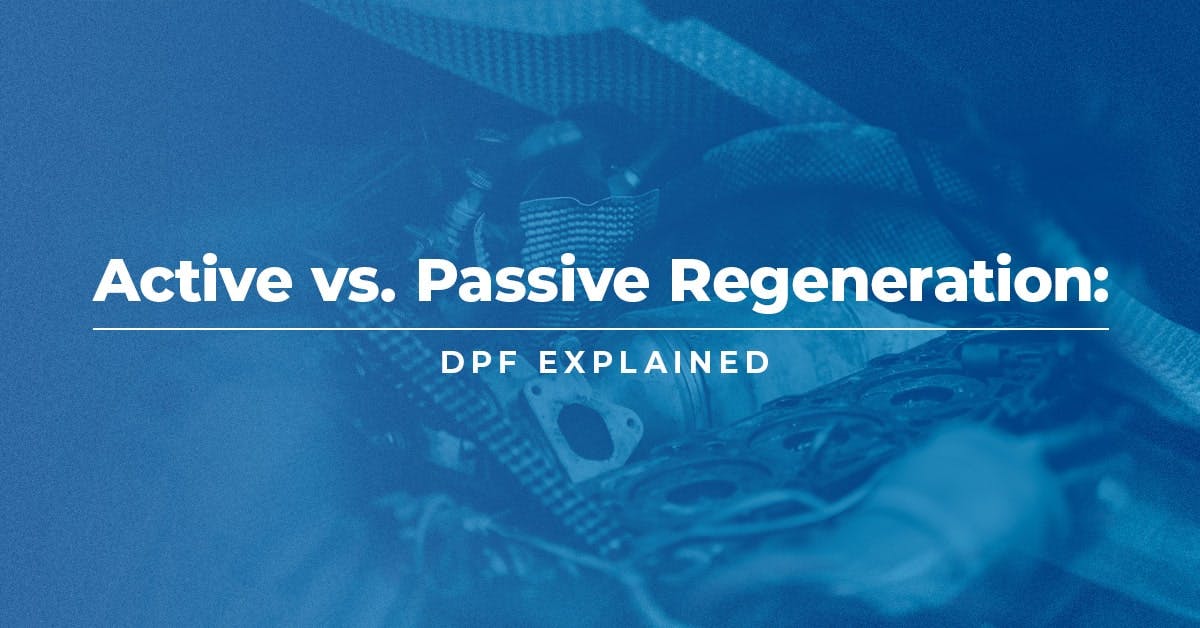If you own a diesel car, then you need to know about active and passive diesel particulate filter regeneration.
In diesel cars, the DPF captures and stores exhaust soot to reduce the levels of harmful emissions produced.
For your DPF to run as it should, it goes through a process known as regeneration, in which this soot is emptied – or ‘burned off’.
Read on and learn the difference between active and passive DPF regeneration.
Page Contents
- What Is Active DPF Regeneration?
- What Is Passive Regeneration?
- What Triggers DPF Regeneration?
- Is My Diesel Particulate Filter Blocked?
- Will I Know When DPF Regeneration Is Happening?
- How Long Does DPF Regen Take?
- How Often Does Regeneration Occur?
- What Is Forced Regeneration?
- Should I Book a DPF Clean?
What Is Active DPF Regeneration?
Active regeneration is a more controlled process that is started by the engine control unit (ECU).
The ECU uses sensors to monitor the exhaust gas temperature, pressure and flow rate to determine when active regeneration is required.
Extra fuel is sent to the exhaust, so that its temperature can be raised to burn off the excess soot that is blocking your DPF.
If you tend not to drive long distances, then your car will struggle to burn off excess soot without active regeneration.
This is because your vehicle won’t be in use long enough to complete the regeneration cycle.
What Is Passive Regeneration?
Passive regeneration is another way that your DPF is designed to empty itself, and it should happen when driving normally.
When the temperature of the exhaust gas is high enough to burn off the particulate matter, passive regeneration can take place.
This process is not always effective for vehicles that are only used for short trips or driven in colder weather conditions, however.
What Triggers DPF Regeneration?
Your car’s electronic control unit (ECU) will recognise when active regeneration is needed and start the process accordingly.
To trigger passive regeneration, you need to take your car for a longer drive so that the exhaust can reach a higher temperature.
Drive at a higher speed on the motorway so that the speed and temperature increase can create a chemical reaction in your DPF to neutralise the soot.
A layer of ash will be left behind, which can harden and damage the DPF over time.
Regeneration will not get rid of the ash at this stage.
Whilst soot can be removed with a professional DPF clean, the DPF may need to be removed, cleaned or replaced if too much ash has accumulated.
Is My Diesel Particulate Filter Blocked?
If your DPF is becoming blocked, then an orange light will appear on your vehicle’s dashboard.
It will typically look like a piped box with dots in the middle, but the design can vary by manufacturer.
You can refer to your vehicle handbook for more information.
To take care of your vehicle’s DPF, it is important that you have a professional car service each year and use the right oil for your vehicle.
Will I Know When DPF Regeneration Is Happening?
Active regeneration may be taking place if you notice any of the following:
- The engine sounds different
- A hot, unpleasant exhaust smell
- The cooling fan is running
- Faster engine idle speed
- The car is using more fuel
Regeneration could also be taking place if your car’s automatic start/stop technology isn’t working.
All of the above are normal symptoms of active regeneration.
You should trigger passive regeneration if you drive on the motorway for 15 minutes or more at a speed of at least 40mph.
How Long Does DPF Regen Take?
DPF regen can take anywhere from 20 to 30 minutes for the cycle to complete under normal operating conditions.
The duration of diesel particulate filter regeneration can vary depending on your vehicle’s make and model, as well as the driving conditions and efficiency of the regeneration system.
The process could take longer if the DPF is clogged with soot or if the vehicle has not reached the required operating temperature for regeneration to occur effectively.
Your DPF will not be able to complete the cycle if:
- There isn't enough fuel in the fuel tank
- The fuel light is on
- The engine management light is on
- The pressure sensors aren't working
- The pressure pipes aren't working
- You aren't using the right engine oil
- The oil is contaminated
- Your fuel additive level is low
Be aware of these factors, and you can help your car to properly complete the DPF regeneration cycle.
How Often Does Regeneration Occur?
The frequency of DPF regeneration can vary depending on how often you drive your car and the type of engine you have.
Active regeneration happens roughly every 300 miles and is triggered by your car’s ECU once soot levels are approaching 40 to 45%.
Passive regeneration should occur naturally when taking your car on longer journeys at higher speeds.
What Is Forced Regeneration?
Forced regeneration is a process in which certain garages can clean blocked DPFs using special diagnostic tools.
This process can cost you around £100 and usually removes the excess soot – though it is not a guaranteed solution to the problem.
You must maintain your DPF through your driving habits and vehicle maintenance routine, as some engines won’t restart if the diesel particulate filter becomes sufficiently blocked.
Your vehicle may even enter ‘limp home’ mode.
If the DPF warning light stays on, turns red, or more lights come on, you should have your vehicle looked at by a skilled garage soon.
Should I Book a DPF Clean?
Any of the following DPF problems can indicate that it is time to book a DPF Clean:
- A loss of power
- Increased fuel consumption
- Smoke coming from vehicle
- Rising oil level
- Automatic start/stop system not working
A dashboard warning light showing an amber exhaust is another warning sign to look out for.
If your DPF isn't regenerating as it should, then you should book a DPF clean.
The process itself can take around 1 to 2 hours to complete.
We recommend that you book in for a DPF cleaning every 6 to 9 months, so that you can make sure you prevent the need for an expensive DPF replacement.








2 replies to "Active vs. Passive Regeneration: DPF Explained"
Clinton
June 25th, 2024
Eve McPherson
June 28th, 2024
Leave a comment